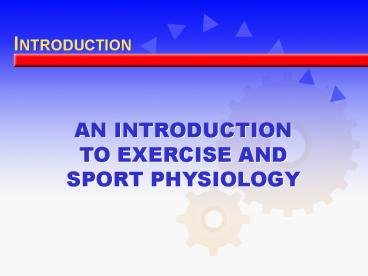Learning Objectives - PowerPoint PPT Presentation
1 / 17
Title:
Learning Objectives
Description:
w Learn to differentiate exercise physiology and sport physiology. w Become familiar with the ... Research Methodology. Organizations. ACSM. NSCA. NATA ... – PowerPoint PPT presentation
Number of Views:76
Avg rating:3.0/5.0
Title: Learning Objectives
1
(No Transcript)
2
Learning Objectives
w Learn to differentiate exercise physiology and
sport physiology.
w Become familiar with the evolution of exercise
physiology.
3
Learning Objectives
w Learn what factors affect the body's acute
response to exercise.
w Understand the six basic principles of training.
4
Exercise Physiology vs Sport Physiology
Exercise physiology studies how the bodys
structures and functions are altered when exposed
to acute and chronic bouts of exercise.
- Sport physiology applies exercise
physiology concepts to an athlete's training
and performance. - Health Related Physiology
5
Early Exercise Physiologists
Archibald V. Hill w Nobel Prize winner (1921) w
Studied energy metabolism w First studies on
runners
John S. Haldane w Developed methods to measure
oxygen use during exercise
6
The Harvard Fatigue Laboratory
w Founded by Lawrence J. Henderson
w Directed by David Bruce Dill
w Focused on the physiology of human movement and
the effects of environmental stress on exercise
7
The Scandinavian Influence
Erik Hohwü-Christensen w Published important
early research on carbohydrate and fat
metabolism
Per-Olof Åstrand w Conducted studies on physical
fitness and endurance capacity
Jonas Bergstrom w Reintroduced biopsy needle to
study human muscle biochemistry
8
Contemporary Exercise Physiologists
John Holloszy and Charles Tipton w Introduced
biochemical approach to exercise physiology
research w First to use rats and mice to study
muscle metabolism and fatigue
Reggie Edgerton, Phil Gollnick, and Bengt
Saltin w Studied individual muscle fiber
characteristics and their responses to training
9
Most contemporary fitness oriented
- Dr. Kenneth H. Cooper
- Dr. Steven N. Blair
- Dr. Ralph Paffenbarger
- Dr. Russ Pate
- Dr. Claude Bouchard
- Dr. I-Min Lee
10
Most Contemporary cont.
- Dr. Michael Stone
- Dr. William J. Kraemer
11
Acute Responses vs Chronic Adaptations
Acute responses to training involve how the body
responds to one bout of exercise.
Chronic physiological adaptations to training
mark how the body responds over time to the
stress of repeated exercise bouts.
12
Measurable Physiological Variables
w Heart rate
w Respiration rate
w Skin and deep body temperature
w Muscle activity
13
Key Points
Acute Responses to Exercise
w Control environmental factors such as
temperature, humidity, light, and noise.
w Account for diurnal cycles, menstrual cycles,
and sleep patterns.
w Use ergometers to measure physical work in
standardized conditions.
w Match the mode of testing to the type of
activity the subject usually performs.
14
Basic Training Principles
IndividualityConsider the specific needs and
abilities of the individual.
SpecificityStress the physiological systems
critical for the specific sport.
DisuseInclude a program to maintain fitness.
Progressive overloadIncrease the training
stimulus as the body adapts.
Hard/easyAlternate high-intensity with
low-intensity workouts.
PeriodizationCycle specificity, intensity, and
volume of training.
15
Key Points
Research Methodology
w Longitudinal research tests the same subjects
and compares results over time.
w Cross-sectional research collects data from a
diverse population and compares against groups in
that population.
16
Key Points
Research Methodology
w Laboratory research allows investigators to
carefully control variables and use accurate
equipment.
w Field research allows for less control of
variables and equipment, but participants
activities are often more natural.
17
Organizations
- ACSM
- NSCA
- NATA































